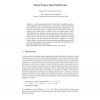Free Online Productivity Tools
i2Speak
i2Symbol
i2OCR
iTex2Img
iWeb2Print
iWeb2Shot
i2Type
iPdf2Split
iPdf2Merge
i2Bopomofo
i2Arabic
i2Style
i2Image
i2PDF
iLatex2Rtf
Sci2ools
GMP
2006
IEEE
2006
IEEE
Tuned Ternary Quad Subdivision
A well-documented problem of Catmull and Clark subdivision is that, in the neighborhood of extraordinary point, the curvature is unbounded and fluctuates. In fact, since one of the eigenvalues that determines elliptic shape is too small, the limit surface can have a saddle point when the designer’s input mesh suggests a convex shape. Here, we replace, near the extraordinary point, CatmullClark subdivision by another set of rules derived by refining each bi-cubic Bspline into nine. This provides many localized degrees of freedom for special rules so that we need not reach out to, possibly irregular, neighbor vertices when trying to improve, or tune the behavior. We illustrate a strategy how to sensibly set such degrees of freedom and exhibit tuned ternary quad subdivision that yields surfaces with bounded curvature, nonnegative weights and full contribution of elliptic and hyperbolic shape components.
| Added | 11 Jun 2010 |
| Updated | 11 Jun 2010 |
| Type | Conference |
| Year | 2006 |
| Where | GMP |
| Authors | Tianyun Ni, Ahmad H. Nasri |
Comments (0)

